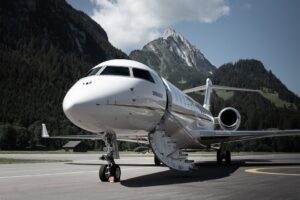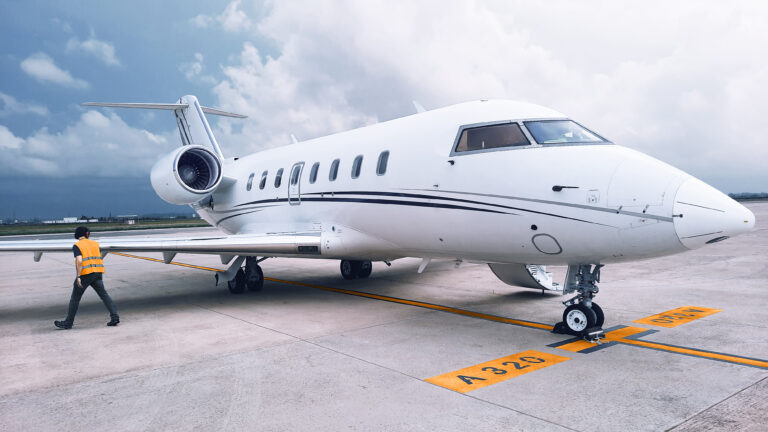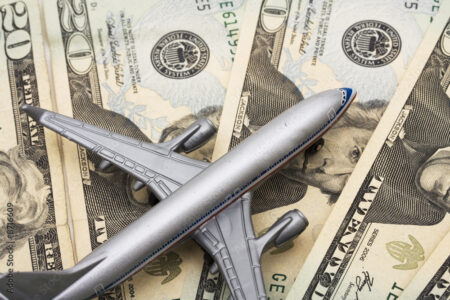The general aviation industry is facing challenges when it comes to parking availability for private jets, particularly at popular tourist hotspots. Business aviation experienced unprecedented levels of demand after the Covid-19 pandemic, specifically between 2019 and 2022 when users prioritized comfort, reliability, and safety at a time when there was reduced service from commercial airlines.
With more people flying and enjoying the flexibility of private aviation worldwide, there is increasing demand and competition for parking spaces. This demand is particularly high during peak summer months in the northern hemisphere, starting around mid-June until early September.
From an operational perspective, there can also be difficulties when it comes to establishing greater coordination between handling agents, airport personnel and authorities, which can make arranging parking very challenging. As a result of these obstacles, private aircraft can be required to reposition to nearby terminals – some even an hour away from the initial destination – thus generating more movements while adding more emissions to the environment.
Yet how bad really is the situation? It varies per location, notes Robert Baltus, chief operations officer at the European Business Aviation Association (EBAA). “In the worst-case scenario, aircraft have to position out, which is the last thing we want from an environmental and cost perspective,” he says.
Aron Modis, manager of ground operations at Axis Aviation states that the difficulty with finding parking will vary depending on when you are looking to park and how early the request for parking is logged.
“Business aviation is a more ad-hoc style of traveling, which means it is rare a parking request is filed months in advance. This means finding parking can prove difficult at popular destinations at peak times of the year, particularly at the weekend.”
Kevin Singh, president of Icarus Jet, an air charter service for private jet and helicopter flights, bluntly shares that the situation is catastrophic and harmful to the climate. “This bottleneck is caused by negligence,” he says.
He adds that finding available slots at aviation hotspots is next to impossible. “Parking areas in Zürich and Athens have been under construction for two years and many airports are actively trying to ban private aircraft access to the airport itself.”
For Baltus, there are two different kinds of availability issues – chronic and seasonal ones.
“The chronic ones are at places like London City, and the seasonal ones occur either in winter or summer holiday hotspots. Both become more visible as our industry shows growth, while commercial aviation simultaneously makes a comeback,” he says.
Today, a common scenario for operators is to reposition an aircraft at a secondary airport due to a maximum ground time allowance of 12 hours at some terminals. Far from ideal, improved infrastructure is not possible in all terminals, not just because of a lack of investment, but because of geographical reasons, as Modis describes.
“In destinations like the south of Italy or on Greek islands, for instance, there is a geographical limitation on increasing capacity, which means that the parking situation can become busy and volatile, particularly during peak periods. While there has been an increase in charter brokers looking to meet this demand, parking availability hasn’t grown at the same rate,” says Modis.
Yet not all problems are associated with infrastructure, with some airports in Greece not operating 24/7 or lacking customs or immigration personnel after certain hours, as Athanasios Nikoglou, chief operating officer at Proton Air Services, explains: “In Greece, there are not enough hangar facilities because at most airports there is no room to accommodate more construction.
“However, in some places, there is capability but without specific construction plans or an invitation for investment from the private sector.”
Impact of commercial aviation

Another key variable to parking issues is understanding who is competing for the slots. Commercial aviation has registered a notorious rebound since the pandemic, returning to near-normal demand numbers worldwide, and commercial passengers also want to visit beautiful places like Mykonos, Ibiza, or the French Riviera. This reality adds more stress to the situation especially during peak season, as highlighted by Singh.
“Commercial aviation has priority at most of these airports, as Europe lacks GA airports compared to the USA. Airlines are purchasing more aircraft and require more gates and ramp areas. Athens and Zürich have started converting GA ramps to convert them to airline parking,” he says.
Along the same lines, Baltus believes that both segments are interconnected. “Parking spaces and slots are closely related to commercial aviation, especially at smaller airports, where a small increase in commercial flights can have a significant impact on parking availability.”
There’s also the incentives portion of the equation from an airport standpoint. Nikoglou recognizes that general aviation aircraft are not the desired category of flight for many of the airports due to low revenue from aeronautical charges and because they do not significantly contribute to increasing passenger traffic.
He adds that the lead times in Greece specifically to secure a parking slot are very different between commercial and general aviation, with the latter being able to do so only 14 days prior to the day of operations. Even if you can secure parking permission you may not land an airport slot as different rules are in place and not a single point of communication and application is available,” Nikoglou says.
It is not always straightforward to find parking space in Lisbon either, notes Modis, regardless of the time of year. “Lisbon is an incredibly popular destination, and the airport is surrounded by a densely populated city, making it harder to expand hangar space.”
Improving infrastructure
With limited resources and space in some locations, the long lead time required to increase facilities is detrimental to any attempts to ease aircraft parking problems.
Baltus says, “Hangarage is always behind aircraft deliveries. More capacity has been built at secondary locations, but there is still a shortage in some areas. Certain business models in our industry, like fractional and charter operators, use floating fleets and make less use of hangarage compared to corporate and private owners,” he says.
Singh agrees: “Hangars are expensive to build and maintain. We don’t need hangars as much as we need to extend ramp areas to accommodate overnight parking. The hangars at most major airports are very expensive with Switzerland topping the charts for hangars per hour rates.”
Modis believes that where expansion is geographically possible, there will be plans to expand if the demand exists. While more hangarage is often beneficial, development work at an airport or FBO can take months and the facilities may need to close completely during the upgrade.
“As well as this, it isn’t always physically possible to expand at airports that have limited surrounding space to build more hangars or there may be environmental considerations that restrict airport expansions.”
Singh believes that most countries don’t invest in infrastructure alongside increases in private aircraft ownership. “Post-Covid the US market is growing at 3% and more Americans are buying private aircraft. But the European economy isn’t booming and investing in airports,” he says.
The Greek conundrum

With tourism contributing directly or indirectly to almost 20% of Greece’s GDP, it is important to the Greek business aviation sector that it fully understands the aircraft parking situation in the country’s main ports of entry. Greece has around 40 international, national, and municipal airports, although only a few of them have parking capability for business aviation aircraft.
At the international airports, except for Thessaloniki (LGTS), there is no parking capability at all, while some national airports usually cannot accommodate more than 1 or 2 aircraft. In municipal airports on the other hand, in most cases, the infrastructure does not allow to handle any aircraft with no fuel or catering options available for flights.
The popularity of the destination determines how congested a terminal might be. Regions like Cyclades (Mykonos LGMK, Paros LGPA, Santorini LGSR), the Ionian Islands (Corfu LGKR, Zakynthos LGZA, Kefallinia LGKF), Athens (LGAV) as the capital city and Crete (Heraklion LGIR, Chania LGSA) are facing very big issues with parking congestion even for short term parking periods.
“The bigger issue is the small airport capacity coping with the extremely crazy demand during specific operating hours while creating a peak period of both commercial and general aviation aircraft,” says Nikoglou.
Most Greek airports experience significantly increased levels of traffic during the summer months, especially from June until the middle of September. In some cases airports will only permit ground time of a maximum of 40 minutes, and in other cases do not approve parking for more than 12 hours.
“The situation is very hard, and you need a reliable partner that has the capability to deal with it regionally and who has a physical presence in most hotspots to handle your aircraft and provide the best alternatives.
“This is the reason behind our rapid expansion to as many hotspots as possible, like Athens, Mykonos, Paros, Corfu, Santorini, Heraklion, Thessaloniki and Aktion,” highlights Nikoglou.
Looking ahead

Apart from the seasonality impacting parking availability there are yearly events that add stress to the system.
This year, the UEFA European Football Championship could increase congestion, explains Modis, “Although the famed German efficiency means this could be managed effectively presuming there aren’t strikes or construction work as there is now.”
He adds that the 2024 Olympics will also likely cause parking challenges in Paris, prompting people to consider airports outside of Paris.
With no major infrastructure investments projected for the year, an improved reservation system and cross-collaboration between handlers and airport authorities might be the best way to mitigate the issue. Are there effective reservation systems in place to manage and allocate parking slots for private jets?
“Not really,” says Singh. “Just like with hotel bookings, people would rather book random dates than wait for confirmed ones and this results in overbooking, especially by fractional and charter operators who use ghost bookings to secure parking.”
In Greece, Nikoglou does see an improvement in the parking allocation. “Some airport operators are providing effective reservation systems while in some other cases, the operator is forced to wait until the very last moment for an approval or a decline of their request,” he says.
Furthermore, staffing in aviation has been an issue since the pandemic, and finding qualified employees is a challenge throughout Europe. From ramp workers to pilots, the shortages in personnel are also a considerable variable that impacts the overall parking situation.
“Access to talent is an issue across business aviation. Certainly, ensuring there are adequate staffing levels in some smaller islands, such as Ibiza, is not proving straightforward,” Modis says.
In essence, with slots, operating hours, and overnight parking restrictions almost certain at most airports, the reality today is to expect intensified congestion at destinations that are seasonally popular while geographically limited, like southern Italy, the Greek islands, and Ibiza.
Planning ahead and relying on the services of local, certified, and experienced service providers with established relationships with the national airport authorities of the visiting country, will be paramount for securing an improved private aviation experience when visiting Europe’s private jet hotspots in the upcoming summer season.





